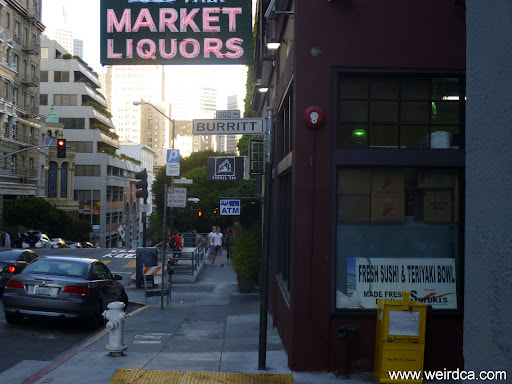|
We are losing it, aren’t we? The city we came to love. San Francisco. We are losing it, bit by bit, day by day. The word that Macy’s is planning to close its flagship store on Union Square is another clear sign. The place we used to call the City, as if there were no other, is fading away. And we won’t see it again. Everybody knows the story by now — Macy’s, the New York-based chain, said it planned to close 150 “underproductive” stores across the country by 2026. The San Francisco store was on the list. The Chronicle called the news about the San Francisco store “a bombshell.” I’m not sure it was a bombshell at the 149 other doomed stores, but they’re not San Francisco. San Francisco, we thought, was special. And Macy’s, a huge battleship of a store, was special to San Francisco. The store takes up nearly a full block of valuable Union Square real estate — 400,000 square feet of merchandise, eight floors from cookware and a branch post office on the lower level to the Cheesecake Factory restaurant on the top floor, which offers dinner and lunch and 40 varieties of cheesecake for dessert. Macy’s is more than a big store. It’s the anchor of the Union Square shopping area, our Fifth Avenue, our Rodeo Drive, our Miracle Mile. There was an ice rink in the square in winter, and Macy’s put up a huge Christmas tree every season. One year the store advertised “the magic of Macy’s” and another year there was an uproar when the store fired the Santa Claus, the fella they had hired to spread magic to the kids. Macy’s firing Santa Claus? Holy Kris Kringle! That was almost as unthinkable as Macy’s leaving San Francisco. Macy’s won’t leave San Francisco right away. First, the company wants to find a buyer for the property. It’s economics, of course: property is worth more than the business. So, the store will stay open and gradually fade away, like an old photograph. That’s the way change happens to cities. Slowly, bit by bit, so you hardly notice. That’s what’s happening to San Francisco. San Francisco was all a myth anyway: Dashiell Hammett, Jack London, Bill Saroyan, John Steinbeck, Mark Twain, Robert Louis Stevenson, Frank Norris, Jack Kerouac, Tony Bennett, and Herb Caen. They invented it. Writers said San Francisco was one of three story cities. New York and New Orleans were the other two. Film makers, too: Alfred Hitchcock, Garry Marshall, Chris Columbus, Wayne Wang. Filmed here were The Maltese Falcon, Dirty Harry, Woman on the Run, Bullitt, Superman, Hulk, The Wedding Planner, Dawn of the Planet of the Apes, Forrest Gump, What's Up Doc, A View to Kill, The Birds, The Candidate, Interview With the Vampire, and the list goes on. The city had character. And characters. Remember the NO SEX guy at Powell and Market? The sidewalk musician who called himself the Automatic Human Juke Box? The siren that went off every Tuesday at noon? The identical Brown Twins who graced downtown streets? The grand funeral at Grace Cathedral for Jose Sarria, the drag queen and gay rights pioneer? A ceremony “fit for an empress,” the Chronicle said. Only in San Francisco. We had all that and grand restaurants and destination stores as well: I Magnin, Nordstrom, the City of Paris, Macy’s. The Gap and Levi Strauss were founded here. There was something in the air in San Francisco. You could feel it. Then something changed, like the air going out of a balloon. Not all at once. Slowly. Surely you noticed. The homeless situation became a crisis, housing became a crisis, the city’s quality of life became a crisis: busted car windows, graffiti scrawls everywhere. The big drug stores started locking the shelves. One Sunday last month the Chronicle ran a huge front-page headline: 806. That was the number of drug overdose deaths in 2023. Nobody’s to blame. It wasn’t one thing. It was all things: drugs, the economy, a bad rap from the international media, a shift in style, the rise of the internet, the arrival of technocrats (X, formerly Twitter, and several more), the fall of retail, the decline of style in everyday life, the COVID breach, an ineffective city government. All those things. It has been a bad year, maybe a tipping point. A third of the retail space downtown is empty. Last summer Nordstrom closed and the Westfield mall on Market Street emptied out. Anchor Steam Beer shut down. And now Macy’s. When I heard the news, I walked through Macy’s. It felt the same as I remembered, the merchandise all new, glittering. The main floor has a distinct smell, part perfume, part department store. I walked past the jewelry displays, past the cases full of pretty watches, skipped the elevator, rode up on the escalator on the Geary Street side, a moving stair through a marketplace, elegant gowns, racks of men’s sport coats and suits, a floor full of beds and pillows and sheets. A department store like Macy’s is uniquely American. It’s our style. “The Look You Love” the sign says. I went to the wine bar on the third floor and looked out — at Saks Fifth Avenue, at Tiffany & Co., at the Apple Store, and at the Union Square shops around Macy’s — a busy afternoon in the center of the city. It was toward the end of the day, and I wondered how long this scene will be there after Macy’s is gone. Because it won’t last. Better go and enjoy the city we still have. Native Burrit Alley, a dark street roughly 75 feet long (I never actually measured it), is the spot where Humphrey Bogart finds his partner in The Maltese Falcon, photo courtesy of Weird California. RLS lived at 608 Bush, not far from Burrit.
0 Comments
Leave a Reply. |
Categories
All
Archives
May 2024
|

 RSS Feed
RSS Feed